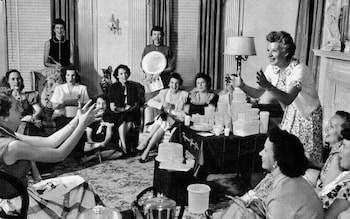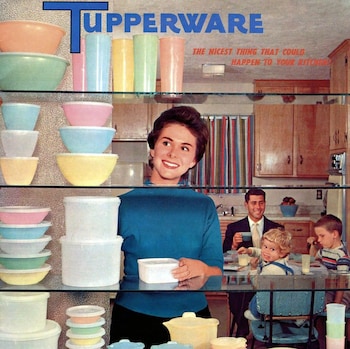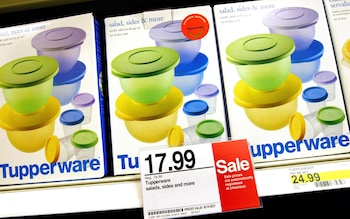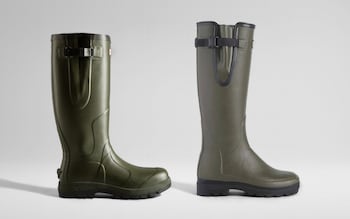To anyone raised in the era of apps and anonymous online shopping, Tupperware parties – which involve inviting people into your home to show them actual items for sale – probably sound like science fiction. Perhaps that’s part of the reason why the venerable American company, once so popular that it became synonymous with plastic storage containers, has this week filed for bankruptcy and is seeking potential new buyers.
It’s a sad turn of events for this formerly industry-leading business, which was founded in 1946 by Earl Tupper. He developed the airtight Tupperware container, made of polyethylene, transforming our ability to store food and keep it fresh for longer.
But it was Brownie Wise who turned Tupperware into a phenomenon via a direct marketing strategy known as the “party plan”. Tupperware would supply women with their products and teach them how to throw parties and sell their wares, so growing the market via the domestic sphere and capitalising on existing relationships. After all, we’re much more likely to buy something from someone we know and trust – especially if it’s in a fun context.
Wise was a busy single mum (she left an abusive husband) and shrewd saleswoman who understood the mindset of the post-war suburban housewife. Technology had made managing a home significantly easier, but she was terribly isolated: surrounded by gadgets instead of servants. Her role had also shifted into that of the hostess.
Tupperware parties were the perfect fit, offering a new way of socialising, bringing women together, giving them shiny, cutting-edge products to buy and show off in their homes, and supplying entertainment via the product demonstrations. Wise’s party trick was to prove Tupperware’s durability by filling a Wonder Bowl with grape juice, sealing it up, and hurling it across the room.

Tupperware slightly lessened women’s domestic drudgery, too. Instead of cooking every meal from scratch, they could batch cook and store the leftovers.
It was a godsend for women who wanted to work, but were forced to fit in employment around family life and childcare duties. They could host parties whenever they wanted, and do it all from home.
Wise was shrewd about incentivising her new workforce. She created a multi-level pyramid model with sales directors who received commissions from their team members, thereby encouraging them to manage their distributors and recruit more.
By 1952 Tupperware’s annual sales topped $2 million (the equivalent of £18 million today), the brand went global, and Wise became the first woman to make the cover of Business Week magazine.
Ann Tomline is still proudly using her favourite Tupperware 60 years on, including a treasured mixing bowl-cum-cake box. “I had set my heart on it, but it cost £5, and my housekeeping money was only £3. My godson Ian went to a Tupperware party specially so he could buy it for me as a wedding present.” Tomline was married for a very happy 54 years but recently lost her husband, so the cake box holds special memories.
Tupperware parties were a great way to meet your neighbours in a new area, she recalls. “We moved to Hitchin in Hertfordshire in the 1960s, and I began attending parties there. They were wonderful for young mums because we didn’t have all those activities you get now and we didn’t have a lot of money. We could get together at someone’s house, usually in the evening, and there would be tea and biscuits, maybe a cake for close friends – no one was competitive about what you served.”
It was an opportunity to vent, too. “We would usually talk about our husbands!”
Tomline gave a couple of parties herself. “You didn’t really make money, but you would get a piece of Tupperware equivalent to the value of what was sold – and if you got a really good demonstrator, she might sell £60 worth. People would put in their orders at the party and pay for it when it came in. Everyone was very honest.”
Today Tomline regularly uses her Tupperware bread container from the 1960s, as well as her cake box. “I certainly got my money’s worth! If I make a cake for something in the village, I always put a sticker with my name on it on my box so that I get it back.”
The system was still going strong in the 1980s when Alison Lester, who now runs the website Tupperware Queen, attended her first Tupperware party. “I’d just moved from London to Taunton and bought my first flat. I was newly married, in my 20s, and I went to a party next door. I was recruited from that,” she recalls. “I went on to run parties for about four years.”
A manager accompanied her for the first couple, “and then I was let loose to do it on my own. In the beginning people came to me, and gradually as you got to know them, more and more would run their own party. It was a whole mix of ages. It started off with my friends, then they would bring somebody, they might bring their mother, and soon everyone was coming. It was like a cult, really!”
Lester says they would get in new products each month, and she would often host two or three Tupperware parties a week. “It was a very popular thing, and building up a collection became an obsession. It worked well because even if you didn’t have much to spend, you could buy one container one week, then wait and buy something else the next time.”
Product demonstrations were key, she explains. “Everyone loved the seal ‘burp’: you’d lift the lid a tiny bit to let some air out, which made a burping sound. I would always choose a recipe and take that dish in a container, and then people could enjoy eating it. We’d play games to get to know each other, and I’d hand out freebies like orange peelers and little salt and pepper shakers.”
If a woman subsequently hosted her own Tupperware party, she would receive a free gift – “You’d offer up something nice and tempting,” says Lester – while the distributors would earn about 25-30 per cent of the product value.
Like Tomline, Lester says the social aspect was vital. “I made a lot of friends through the parties. This was in the days before mobile phones and Facebook, when you actually talked to each other and visited each other’s houses. No two parties were the same. Sometimes it was a cup of tea, sometimes it was a glass of wine, or a few!”
Lester, who hosted her parties alongside a full-time job, went on to a sales career, but she says for many women this was their only source of income. “There were a lot of stay-at-home mums. You could do as much or as little as you wanted.”

Sadly, the party is now over for Tupperware. In 2022 the company’s stock value dropped by more than 40 per cent, and in April 2023 it released a statement warning that there was “substantial doubt” that it could continue as a going concern – despite a brief uptick during the pandemic, when more people stayed home and cooked meals. On September 18, Tupperware filed for Chapter 11 bankruptcy.
Although many people will say they’re still buying Tupperware, for the most part they’re actually buying cheaper alternatives. Rivals such as Sistema, Amazon and Joseph Joseph have undercut the brand, but the quality doesn’t compare, argues Lester. “You don’t know what’s in the plastic, so you wouldn’t want to put it in the microwave and have something leach into your food, and you wind up throwing it away because it falls apart.” Food delivery firms have also taken business away from Tupperware by using their own plastic containers.
Tupperware should actually be chiming with contemporary concerns around preventing food waste, buying products that last and don’t harm the environment, and helping people to eke out their food during a cost-of-living crisis. But it’s now hard to source, especially in the UK.

Lester set up her website selling Tupperware products in 2017. Initially she imported from Ireland, but now has to order products from Denmark, which adds to the cost. She enthuses about the wide range – everything from a special fridge-friendly container with a vent to choppers, utensils and child-friendly products – but fears that “the younger generation doesn’t know the difference: they think any old plastic container is Tupperware.”
The brand did recently piggyback onto the retro craze fuelled by hit TV series The Marvelous Mrs Maisel, releasing a vintage collection in 2023 in delectable pastel colours. But nostalgia alone is not a viable business model.
Could the Tupperware party make a comeback? It might be a refreshing innovation for Gen Z, who are glued to their phones but complain about social isolation. Lester recently held one and was delighted to see men coming along too. “It was more like a couples get-together. Men are happy to try it, especially if there’s cake involved.”
If Tupperware is to survive, once again its leaders will have to think outside the box.
Disclaimer: The copyright of this article belongs to the original author. Reposting this article is solely for the purpose of information dissemination and does not constitute any investment advice. If there is any infringement, please contact us immediately. We will make corrections or deletions as necessary. Thank you.



